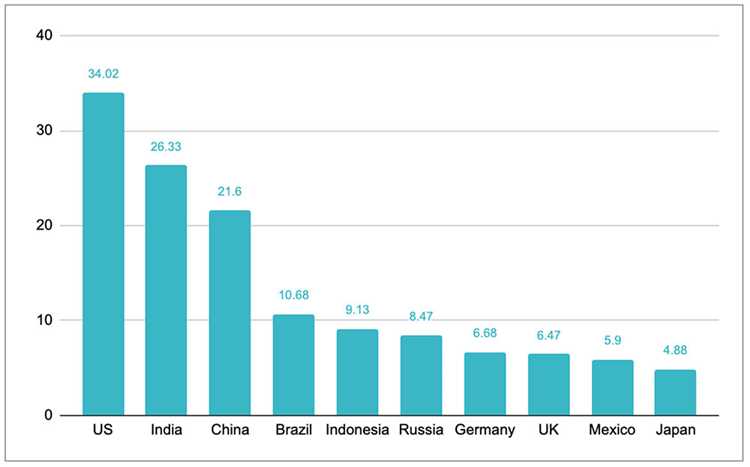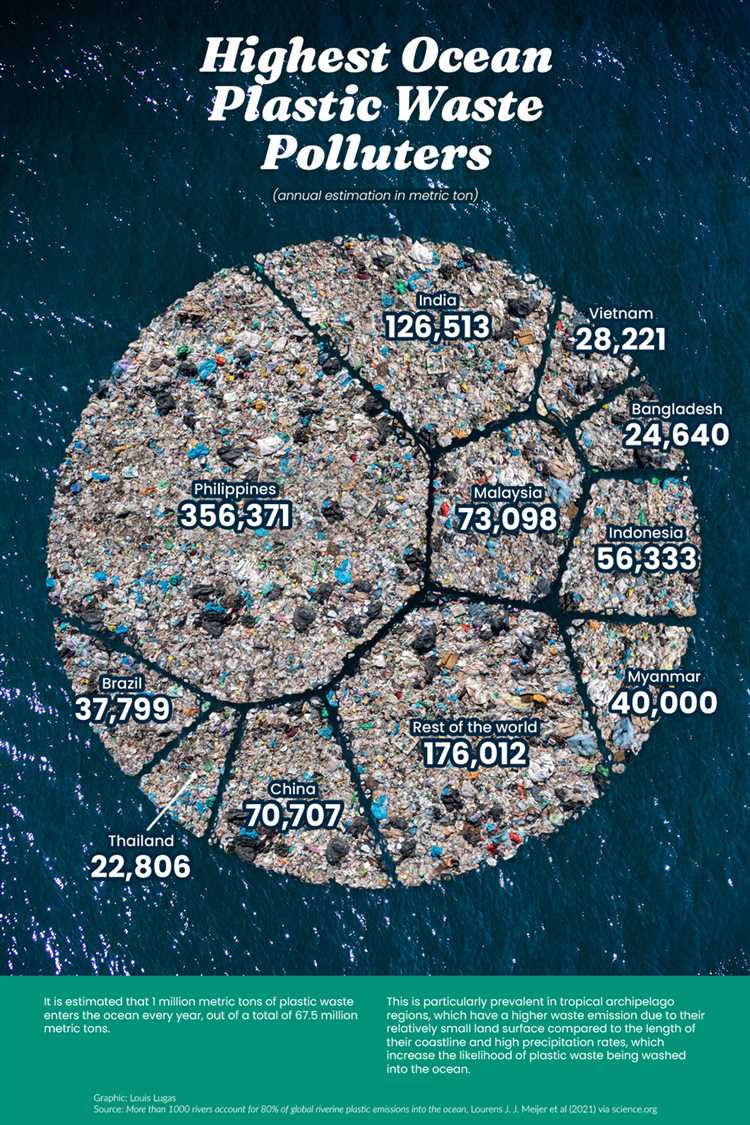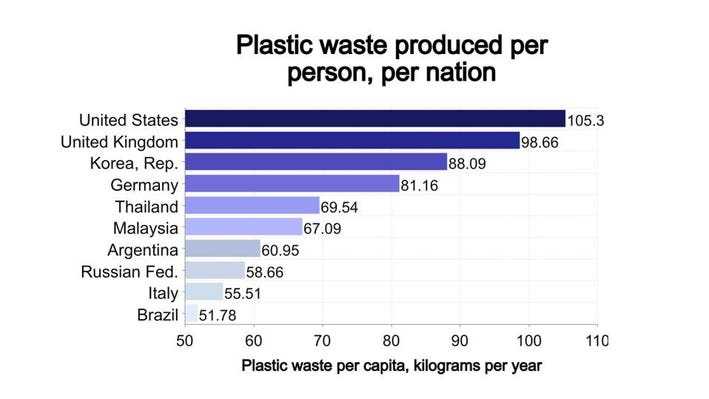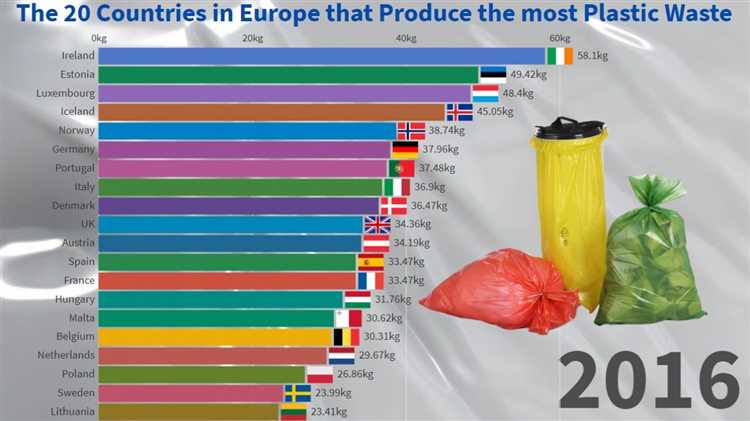
Plastic pollution has become one of the biggest environmental concerns worldwide. With its incredible versatility and convenience, plastic has become an integral part of our daily lives. However, this convenience comes at a cost.
As the demand for plastic continues to rise, so does the amount of plastic waste generated. But which country actually uses the most plastic? Is it the United States, known for its consumerism? Or could it be China, with its massive population?
To answer this question, we need to consider several factors. These include population size, consumption patterns, waste management systems, and environmental awareness. By analyzing these factors, we can determine which country is the biggest contributor to the global plastic pollution crisis.
- The Plastic Pollution Problem in Different Countries
- The Rank of Countries with the Highest Plastic Usage
- The Effects of Plastic Pollution on the Environment
- Initiatives to Reduce Plastic Usage
- Plastic Bag Bans
- Bottle Deposit Systems
- The Role of Government in Plastic Waste Management
- Policy Development and Legislation
- Public Awareness and Education
- Investment in Recycling Infrastructure
- Challenges and Solutions in Managing Plastic Waste
- 1. Environmental Challenges
- 2. Health Challenges
- Individual Actions to Reduce Plastic Consumption
- 1. Bring your own reusable bags
- 2. Say no to single-use plastic items
- 3. Choose products with minimal plastic packaging
- 4. Properly dispose of plastic waste
- 5. Spread awareness and encourage others
- Question and answer:
- Which country uses the most plastic?
- How much plastic does the United States produce per year?
- What is the biggest contributor to plastic pollution?
- Which country has the highest plastic recycling rate?
- How much plastic waste does India generate annually?
- Which country is the biggest consumer of plastic?
The Plastic Pollution Problem in Different Countries
Plastic pollution is a global issue that affects countries all around the world. Unfortunately, some countries have a more severe plastic pollution problem than others. Understanding the plastic pollution problem in different countries is crucial for finding effective solutions to combat this environmental crisis.
One country that is known for its significant plastic pollution problem is China. With its large population and industrial development, China is the world’s largest producer of plastic waste. The country’s fast-paced economic growth has resulted in increased consumption and production of single-use plastics, leading to a massive accumulation of plastic waste.
India is also facing a major plastic pollution problem. The country generates a substantial amount of plastic waste due to its population size and rapid urbanization. The lack of proper waste management infrastructure further exacerbates the issue, causing plastic waste to end up in oceans and landfills.
Similarly, the United States is one of the largest contributors to plastic pollution. The country produces a staggering amount of plastic waste, particularly single-use plastics such as water bottles and food packaging. Despite efforts to increase recycling rates, a significant portion of plastic waste still ends up in the environment.
Plastic pollution is also a significant concern in Southeast Asian countries like Indonesia and the Philippines. These countries face challenges in managing plastic waste due to inadequate waste management facilities and ineffective recycling systems. As a result, plastic waste often ends up polluting rivers and oceans, posing a threat to marine life.
To address the plastic pollution problem in different countries, international collaboration and coordinated efforts are crucial. Governments, organizations, and individuals must work together to reduce plastic consumption, improve waste management practices, and promote alternatives to single-use plastics. Only by tackling this issue collectively can we hope to create a cleaner and more sustainable future for our planet.
The Rank of Countries with the Highest Plastic Usage
Plastic usage has become a global concern due to its harmful effects on the environment. It is important to identify the countries that contribute the most to plastic waste in order to develop effective strategies for reducing plastic consumption and improving waste management systems.
According to recent data, the following countries rank the highest in terms of plastic usage:
| Rank | Country | Plastic Usage |
|---|---|---|
| 1 | China | ~30 million metric tons |
| 2 | United States | ~37 million metric tons |
| 3 | India | ~20 million metric tons |
| 4 | Indonesia | ~10 million metric tons |
| 5 | Brazil | ~9 million metric tons |
It is important to note that these figures are approximate and can vary from year to year. However, they give us a general idea of the countries that have the highest plastic usage.
Efforts are being made globally to address the plastic pollution problem, such as implementing plastic bag bans, promoting recycling programs, and encouraging the use of sustainable alternatives. It is crucial for all countries to work together in order to mitigate the negative impact of plastic on our planet.
The Effects of Plastic Pollution on the Environment
Plastic pollution has become a significant global environmental issue, with its effects being felt in various ecosystems across the planet. The rampant use and improper disposal of plastic products have led to devastating consequences for both wildlife and human beings.
1. Threat to Marine Life
One of the most severe impacts of plastic pollution is its threat to marine life. As plastic waste finds its way into oceans and rivers, it poses a significant danger to marine animals such as turtles, seabirds, and fish. Many marine creatures mistake plastic debris for food and consume it, leading to ingestion and choking. Additionally, animals can become entangled in plastic waste, resulting in injury or suffocation.
2. Damage to Ecosystems
Plastic pollution also takes a toll on ecosystems as a whole. Plastic waste disrupts the delicate balance of aquatic and terrestrial ecosystems by releasing harmful chemicals into the environment. These chemicals can contaminate soil, water, and air, posing a threat to plants, animals, and humans alike. Furthermore, plastic debris can smother and suffocate sensitive habitats, leading to the destruction of vital breeding grounds and habitats.
3. Human Health Risks
The impact of plastic pollution on human health is an area of growing concern. Plastic products often contain toxic substances such as phthalates and bisphenol A (BPA), which can leach into food and beverages. Excessive exposure to these chemicals has been linked to various health issues, including hormonal disruptions, reproductive problems, and even an increased risk of cancer.
4. Economic Consequences
Plastic pollution also has significant economic consequences. The costs associated with clean-up efforts, waste management, and the impact on tourism and fisheries industries are substantial. Additionally, the loss of biodiversity and ecosystem services can have long-term economic effects, including a decline in fisheries, agriculture, and overall productivity.
In conclusion, the effects of plastic pollution on the environment are multifaceted and far-reaching. Urgent global action is needed to reduce plastic consumption, promote proper waste management, and develop sustainable alternatives to plastic. By addressing this issue, we can mitigate the detrimental effects of plastic pollution and protect the environment for future generations.
Initiatives to Reduce Plastic Usage
Many countries around the world have recognized the detrimental effects of plastic pollution on the environment and have implemented various initiatives to reduce plastic usage. These initiatives aim to minimize the production and consumption of single-use plastics and encourage sustainable alternatives.
Plastic Bag Bans
One common measure taken by several countries is the implementation of plastic bag bans. These bans prohibit the use of lightweight plastic bags in retail stores and encourage consumers to switch to reusable bags. By reducing the demand for single-use plastic bags, these bans help to decrease plastic waste and minimize the environmental impact of plastic pollution.
Bottle Deposit Systems
Another initiative to reduce plastic usage is the implementation of bottle deposit systems. In these systems, consumers pay a small deposit when purchasing beverages in plastic bottles. They can then reclaim the deposit by returning the bottles to designated collection points. This encourages recycling and motivates individuals to reduce their plastic consumption by opting for alternative packaging options or reusable bottles.
Various countries have successfully implemented bottle deposit systems, resulting in higher recycling rates and reduced plastic waste in landfills and oceans.
| Country | Year Implemented | Impact |
|---|---|---|
| Germany | 2003 | Over 90% of plastic bottles recycled. |
| Norway | 1999 | 90% decrease in plastic bottle litter. |
| Canada | 1970s | Significantly increased recycling rates. |
The success of bottle deposit systems in these countries serves as a model for other nations looking to reduce plastic usage and promote recycling.
Other initiatives to reduce plastic usage include the promotion of reusable containers for food and beverages, encouraging businesses to find alternatives to plastic packaging, and raising awareness about the impact of plastic pollution on the environment through educational campaigns and initiatives.
Through these various initiatives, countries aim to change consumer behavior, shift towards a more sustainable approach to packaging and reduce the amount of plastic waste entering ecosystems, ultimately helping to protect the environment for future generations.
The Role of Government in Plastic Waste Management
Plastic waste management has become a pressing issue worldwide, and the role of government in addressing this problem is crucial. Governments play a vital role in implementing policies, regulations, and initiatives to manage plastic waste effectively and reduce its environmental impact.
Policy Development and Legislation
One of the primary responsibilities of the government is to develop and implement policies and legislation that address plastic waste management. This includes setting targets for reducing plastic waste, banning single-use plastics, and promoting the use of sustainable alternatives. Governments can also establish regulations to ensure proper disposal and recycling of plastic waste.
Public Awareness and Education
The government plays a significant role in raising public awareness and educating the population about the importance of plastic waste management. This can involve launching campaigns and initiatives to inform individuals about the negative impact of plastic waste on the environment and encouraging them to adopt sustainable practices, such as reducing plastic consumption and recycling.
Additionally, governments can collaborate with educational institutions to incorporate plastic waste management into school curricula, empowering younger generations with knowledge and skills to make informed choices and take responsibility for their plastic waste footprint.
Investment in Recycling Infrastructure

Another crucial role of the government is to invest in recycling infrastructure. This includes establishing and supporting recycling facilities, providing incentives for the private sector to invest in plastic recycling technologies, and implementing efficient waste collection systems. By creating a robust recycling infrastructure, governments can ensure that plastic waste is properly managed and can be efficiently recycled into new products.
Furthermore, governments can collaborate with the business sector to promote the development of innovative solutions for plastic waste management, such as advanced recycling technologies and biodegradable materials.
In conclusion, the government plays a significant role in plastic waste management through policy development, public awareness and education, and investment in recycling infrastructure. By taking proactive measures, governments can contribute to the reduction of plastic waste and the protection of the environment for future generations.
Challenges and Solutions in Managing Plastic Waste
Plastic waste has become a global problem, with countries around the world struggling to effectively manage its disposal. The challenges faced in managing plastic waste are multifaceted and require both local and international efforts to address.
1. Environmental Challenges
One of the main challenges in managing plastic waste is the negative impact it has on the environment. Improper disposal and inadequate waste management infrastructure lead to pollution of land, water bodies, and ecosystems. Plastic waste can take hundreds of years to decompose, leading to long-term harm to the environment and wildlife.
Solution: To combat these environmental challenges, governments and local communities should prioritize recycling and implementing waste management programs. By promoting recycling practices and investing in proper waste management facilities, the amount of plastic waste reaching landfills and natural environments can be reduced.
2. Health Challenges
Plastic waste poses significant health risks to both humans and animals. Plastic pollution can contaminate food sources and water supplies, leading to potential health issues and negative consequences for ecosystems. The toxic chemicals present in some plastics, such as BPA and phthalates, can leach into the environment and have harmful effects on human health.
Solution: To address the health challenges associated with plastic waste, education and awareness programs are crucial. Effective waste management practices, combined with reducing the use of single-use plastics and promoting alternatives, can minimize the harmful effects on human health and the environment.
Conclusion:
Managing plastic waste is a complex issue that requires a comprehensive and collaborative approach. By implementing sustainable waste management practices, raising awareness about the environmental and health impacts of plastic waste, and promoting alternatives to single-use plastics, countries can work towards reducing plastic pollution and creating a cleaner and healthier future for all.
Individual Actions to Reduce Plastic Consumption
As individuals, we have the power to make a difference in reducing plastic consumption. Here are some simple actions we can take:
1. Bring your own reusable bags

Plastic bags are a major contributor to pollution, especially when they end up in our oceans and harm marine life. By bringing your own reusable bags when you go shopping, you can reduce the use of plastic bags and help protect the environment.
2. Say no to single-use plastic items
Single-use plastic items like straws, water bottles, and cutlery are often used only once before being discarded. These items contribute significantly to plastic waste. By refusing to use these items and opting for reusable alternatives, such as metal or bamboo straws and refillable water bottles, we can reduce the amount of plastic waste generated.
3. Choose products with minimal plastic packaging
When shopping, try to choose products with minimal plastic packaging. Look for alternatives like glass containers or products packaged in paper or cardboard. By supporting companies that use less plastic in their packaging, we can encourage the adoption of more sustainable practices.
4. Properly dispose of plastic waste

Make sure to properly dispose of plastic waste by recycling it whenever possible. Separate your plastic waste from other types of waste and place it in recycling bins. This allows the plastic to be repurposed and reduces the amount that ends up in landfills or pollutes our environment.
5. Spread awareness and encourage others
Educate yourself about the impact of plastic consumption and spread awareness among your friends, family, and community. Encourage others to adopt similar practices and consider making better choices when it comes to plastic use. By working together, we can create a positive change and reduce plastic pollution on a larger scale.
By implementing these individual actions, we can all contribute to reducing plastic consumption and creating a greener future for our planet.
Question and answer:
Which country uses the most plastic?
The United States is the country that uses the most plastic, producing more than 38 million tons per year.
How much plastic does the United States produce per year?
The United States produces more than 38 million tons of plastic per year, making it the largest plastic producer in the world.
What is the biggest contributor to plastic pollution?
One of the biggest contributors to plastic pollution is China, as it produces approximately 30 million tons of plastic waste every year.
Which country has the highest plastic recycling rate?
Germany has the highest plastic recycling rate, with about 50% of its plastic waste being recycled.
How much plastic waste does India generate annually?
India generates around 9.46 million tons of plastic waste annually, making it the 12th largest plastic waste generator in the world.
Which country is the biggest consumer of plastic?
According to recent studies, the United States is the biggest consumer of plastic in the world. The country produces and consumes an estimated 36 million metric tons of plastic each year.